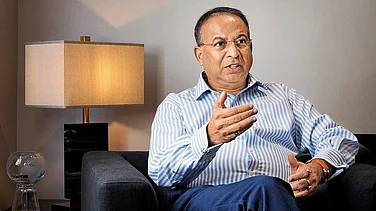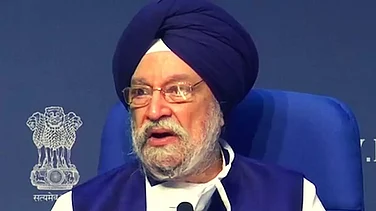As India races towards achieving their Sustainable Development Goals (SDGs) by 2030, gaps in terms of climate finance as well as adaptation continues to persist. Recent reports have revealed that currently, no country is on track to achieve the SDGs that were set by the United Nations nearly 10 years ago.
However, a 2024 UN report had revealed that India has been making progress in several fronts of the SDGs. The fourth edition of the SDG India Index, developed by NITI Aayog gave India a score of 71 out of 100, up from 66 in the previous edition.
In an exclusive interaction with Outlook Business, on the sidelines of TERI's World Sustainable Development Summit, UN Resident Coordinator to India Shombi Sharp talks about India’s progress in terms of achieving the 2030 SDG targets and the need for climate finance to propel India’s trajectory towards ensuring a ‘just green transition’.
How do you assess India's progress when it comes to the Sustainable Development Goals, especially in connection to public health and climate change?
India is a country that has embraced the SDGs as an operational framework, more than any country that I've seen. India was the first country to introduce sub-national SDG index, known as the India SDG index. So the United Nations system here is very privileged to work with government, with NITI Aayog, state governments and ministries on this SDG localization.
With Ministry of Statistics and Program Implementation (MOSPI) dashboard and the National Indicators Framework, our different agencies are working at state level. We have UNDPs working with states on SDG coordination centers, acceleration centers, we have UNICEF, UNHABITAT at all levels - the center and the state, responding to this great appetite and leadership from India in terms of applying SDGs to this cooperative federalism type of model. According to the SDG index, we've seen very significant progress across the board, across the 17 SDGs, there are 16 being tracked in the SDG index. Out of 100, we see a sort of perfect score from 66 to over 70 as well, so we see very important progress.
Additionally, there's a Multidimensional Poverty Index that NITI Aayog is leading. However, we do see that the challenges remain, just as in any country. In India the areas most in need of investment and acceleration, are SDG 5, which is gender equality and SDG 2 looking at nutrition. That's where we need to work together for really maximum acceleration across the board.
But of course, there's not a country in the world that's achieved the SDGs, we still have about five years left until 2030 and a lot of reason to be optimistic, but a lot of work left to be done.
As a developing country in need of climate finance, how much will India be able to ensure a ‘just’ green transition? Are public-private collaborations necessary here?
India is a leading voice for the Global South and one of the most important issues is exactly the ‘just’ green transition. Heard during the COP deliberations as well, India is bringing a very robust appetite for investment in the energy transition, investment and in renewable energy. The Panchamrit - 500 gigawatts of renewable energy, 45% of energy mix, reducing carbon intensity are very ambitious goals and are going to be very difficult to achieve. However, India is moving very rapidly in the right direction.
At the same time, in green transition we still don't have equality of positions across countries. So developing countries in the coming years, including India will need to rely to some degree in on coal. Additionally, there is a moral and a legal obligation among the high income countries to still do more in order to work with developing countries hand in hand and provide technology transfers, financing, etc. Because again, the appetite here is massive as we see incredible investments in renewable energy of all kinds.
Government's putting the leadership position there but it's the private sector which is investing hundreds of billions of dollars. We see efforts to build domestic industry in terms of solar panel production, some fantastic investments in electric mobility with the Indian car makers jumping into the industry.
At the same time, India is one of the most exposed countries in the world in terms of climate impacts and so we have to have a balanced approach. Climate justice is about balancing adaptation and mitigation, mitigating our contributions to climate change and adapting to the impacts that unfortunately are already here. So even if we do everything perfectly from this moment, the major negative impacts are locked in for years to come and thereby one also needs disaster resilient infrastructure.
Unfortunately, we live in a divided world at the moment but India is playing a very important role in terms of bridging divides and moving us towards collective action that we need.
In order to achieve the 2030 SDG targets, what do you think are some of the gaps that India must work on?
In terms of challenges, there are gaps mainly in transmission and storage capacities. Being a diverse country, India has some natural challenges. The government is working hard on that, by putting forth action plans on how to address those inefficiencies. We have some common but differentiated National Determined Contributions (NDCs) that are addressing some of these areas.
One is gender dividend and the other is the demographic dividends. With one million young people a month entering the workforce age, if India can continue to provide jobs, then for the next coming several decades, India will have a very favorable dependency ratio. And that's something that has also propelled some other countries' rapid growth.
Do you think India needs to take lessons from any other country to make the government policies much more sustainable?
At the present moment, India's energy consumption is around one-third of the world's average, and climate emissions are also much lower than many countries, although India is the fifth largest economy in the world.
India is not in a way now the problem if we look at climate emissions. However, given the, the rapid growth now and the major growth path ahead as the country travels through the demographic transition and more urbanization, it's vitally important for India that the trajectory shifts in favor of green economy as quickly as possible. Because, relatively small changes now will have big impacts in the years to come.
So, I would not say that India has to learn but here its more about an exchange of knowledge and here South-South cooperation plays a very important role. We in the United Nations have also partnered with Indian government and the private sector in many different areas of South-South cooperation.



























